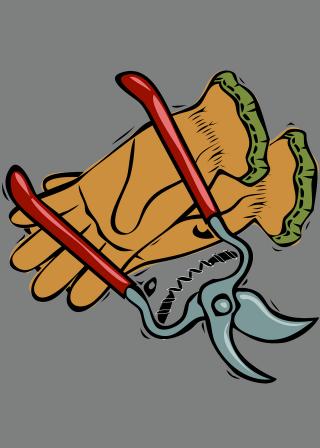This is the act of essentially training a plant or tree. It is the intentional removal of parts (and even large limbs) of a plant. Although, when designing a landscape or managing one that you had no control over designing, it is nice to allow the natural habit and form of a tree or shrub, but sometimes it is necessary to remove parts of the plant that are not structurally sound, can injure someone or property, or need to be removed to encourage proper flowering and fruiting. Pruning requirements vary greatly from species, design intent, and placement in the landscape or garden. Fast growing shrubs generally need frequent pruning whereas slow growing shrubs require little to none. However, there are certain times of the year when a particular species should never be pruned but for other species would be okay. Also, there are particular pruning rules when it comes to fruit bearing trees. Shearing and topping a tree should always be avoided as you are only decreasing the life expectancy of the tree. All pruning should be done with sharp and clean tools.
Pruning

Question:
When should I prune my trees, shrubs, fruit trees, berries, grapes, and roses?
Answer
Pruning is a dwarfing, stimulating and stressful event. It's best to start most pruning January or February. However, diseased or dead limbs and root suckers can be removed at any time.
In the fall plants are slowing down and entering a dormant period. The dormant period is a physiological stage where buds cannot be forced to grow even under ideal conditions. Trees and shrubs are moving compounds from the leaves and branches and storing carbohydrates in the trunks and roots.
Pruning during fall and winter may stimulated buds that are going dormant to begin growing using energy and other resources that are normally stored to survive winter. Next spring's growth takes a lot of energy and if used up in the fall and winter because of pruning stimulation and can cause plants to become stressed and even die if winter conditions are severe.
All of this growth needs to occur in the spring before photosynthesis can begin anew in deciduous plants. Even evergreens' growing activity in the winter slows and in some cases stops. Stimulating new growth is just opposite of what the plant needs to have happen to survive the winter season. This is harmful when plants should be going "to sleep." A plant that has been pruned in late fall can be damaged or killed when it starts growing and a freeze occurs.
Pruning of pine, juniper, cedar, fir, and spruce tree and shrubs should be done during the spring. Pruning is a stressful event for nearly all plants. The mentioned conifers are not growing much if any during the winter season and will have growth start in the spring. Waiting until spring to prune or trim these plants will afford them the opportunity to heal properly because of the strength they will have during the spring push of growth.
Pruning of fruit trees should be done when trees are dormant, after rest is completed in the winter. Generally rest requirements are obtained after Christmas. Pruning can be started in January and continue through bloom in the spring. Fruit trees can be pruned until flower pedals fall. For stone fruits; i.e. apricots, almonds, cherries, peaches, plums and nectarines and for pome fruits; i.e. apples, pears and quince pruning can continue until bloom is completed.
Small fruits; i.e., blackberries, grapes, raspberries, currants and gooseberries are best pruned during the dormant season. Grapes can be pruned through bloom but have a tendency to "bleed". This is not as detrimental as one might think and it is better to prune grapes a little late than let them grow in to a knurled mass! Blackberries and raspberries bare fruit on one year old canes. The two year old canes need to be removed because they have born fruit and are dead. Thinning out weak canes can also be done through bloom. Currents and gooseberries should be dormant pruned by removing wood that is 3 years old by cutting it back to the base or to a main branch.
Roses that bloom several times during the year should be dormant pruned in the late winter or early spring before new growth begins. Roses that bloom only once during the year are pruned after blooming n late spring or summer after flowering. Roses are dormant pruned except in the case of climbing roses which are pruned after flowering.
If you have question on a specific plant's pruning requirements contact the Extension Office in Sierra Vista or Willcox or consult a good pruning book like Sunset's Pruning Book.

